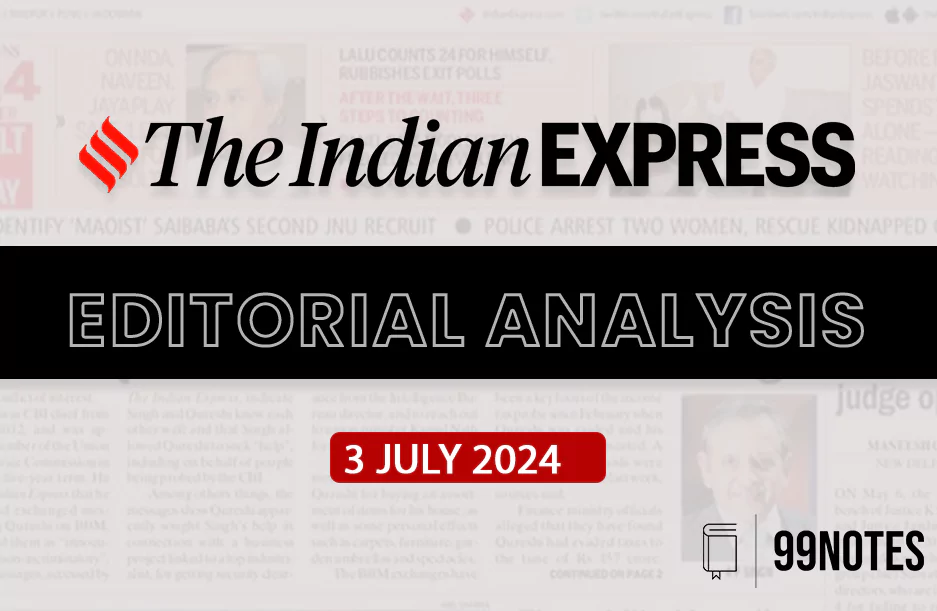3 July 2024 : Indian Express Editorial Analysis
1. The problem with Modinomics
(Source: Indian Express; Section: The Ideas Page; Page: 11)
| Topic: GS3– Indian Economy – Investment models. |
| Context: |
|
The Promise of Modinomics:
- On the surface, Modinomics appears to be a comprehensive plan designed to attract both domestic and international investors.
- With slogans like “Make in India,” the strategy focuses on creating a favorable environment for manufacturing and infrastructure development.
- Key measures include substantial infrastructure improvements, corporate tax cuts, production subsidies, and protective tariffs for domestic producers.
- However, these initiatives have not translated into the expected surge in private investments.
Risk and Return: The Dual Considerations for Investors:
- While improving potential returns is crucial for attracting investments, it is equally important to manage and mitigate risks.
- Investment decisions are heavily influenced by the balance between potential returns and perceived risks.
- In India, the government’s efforts have largely centered on enhancing returns through various incentives.
- Yet, there has been insufficient attention to reducing the risks associated with these investments.
The Reality of Investment Risks in India:
National Champions Risk
- One significant risk is the government’s occasional favoritism towards “national champions”—domestic firms that are positioned as leaders in specific industries.
- This approach often involves sudden policy shifts that benefit selected companies at the expense of others.
- Such unpredictability discourages broader investment, as firms fear that their investments could be undermined by future policy changes favoring their competitors.
Direct and Coercive State Actions
- Another major deterrent is the aggressive and sometimes coercive actions by state authorities, including arbitrary tax demands and selective enforcement by regulatory bodies.
- High-profile cases involving companies like Cairn/Vedanta and Vodafone, where retrospective taxes were imposed, have significantly damaged investor confidence.
- Although the government eventually rolled back some of these measures, the delays and reluctance have left a lasting negative impression.
Supply Chain Risks
- Manufacturing investments are also hindered by supply chain risks. Modern manufacturing relies on a seamless supply of raw materials and components from global sources.
- However, India’s frequent changes in tariffs and import restrictions create uncertainties about the availability and cost of these essential inputs.
- This unpredictability makes India a less attractive destination for manufacturing investments compared to countries with more stable trade policies.
Lessons from Other Economies:
- Comparisons with other economies, particularly China, highlight the importance of a stable investment environment.
- China’s economic strategy has historically combined incentives for high returns with strong assurances to minimize investment risks.
- The recent decline in China’s growth illustrates the consequences of neglecting investor confidence.
- Similarly, Vietnam’s success in attracting investments can be attributed to its consistent efforts to mitigate supply chain risks through free trade agreements.
Conclusion:
- Addressing the weaknesses in Modinomics requires a balanced approach that not only boosts returns but also systematically reduces investment risks.
- The government needs to foster a more predictable and supportive environment for investors.
- This includes refraining from abrupt policy shifts, ensuring fair regulatory practices, and maintaining stable trade policies.
- While challenging, improving India’s reputation as an investment destination is crucial for sustaining long-term economic growth.
| PYQ: Explain the meaning of investment in an economy in terms of capital formation. Discuss the factors to be considered while designing a concession agreement between a public entity and a private entity. (UPSC CSE (M) GS-3 2020) |
| Practice Question: Despite various initiatives under Modinomics aimed at encouraging investment, private investment in India has remained weak. Critically examine the reasons for this phenomenon with a focus on the balance between returns and risks. Suggest measures that the government can take to improve the investment climate in the country. (250 words/15 m) |




